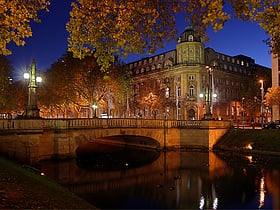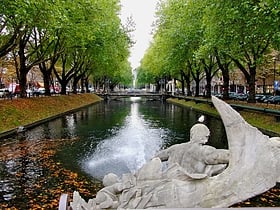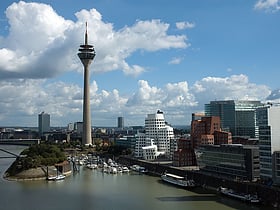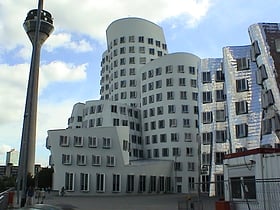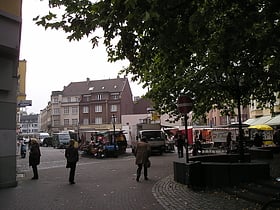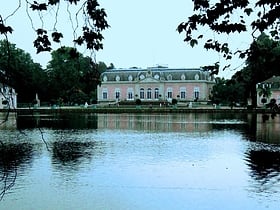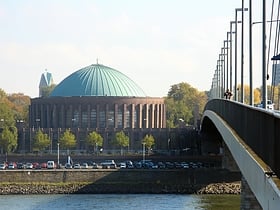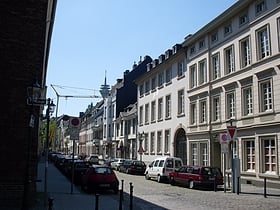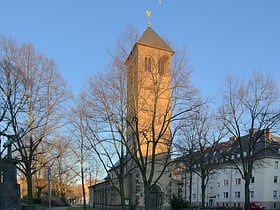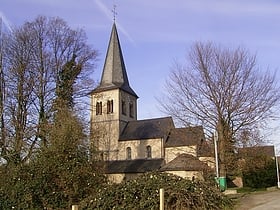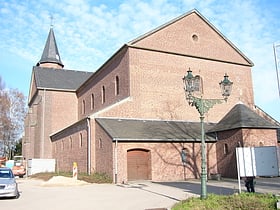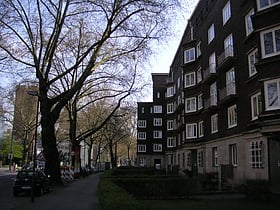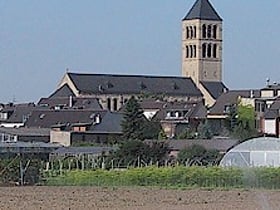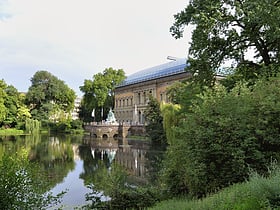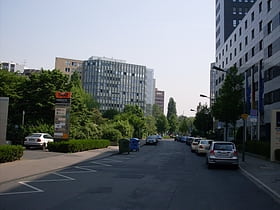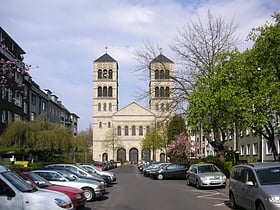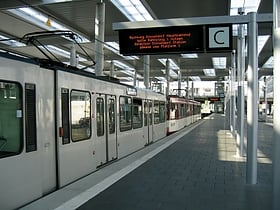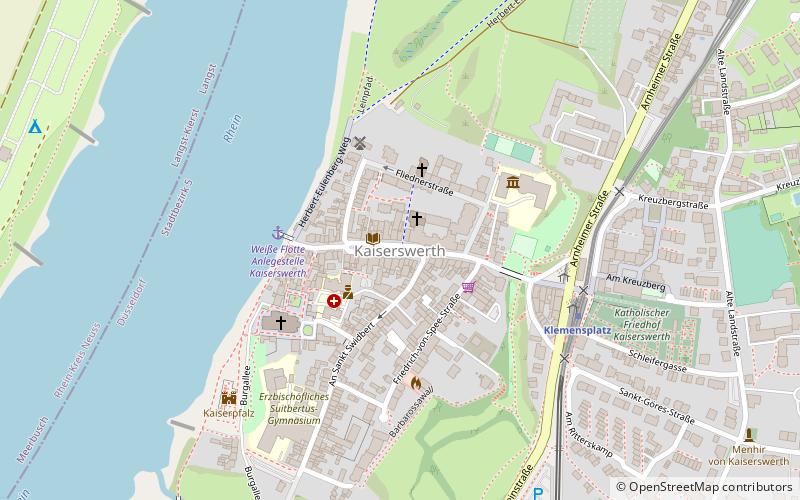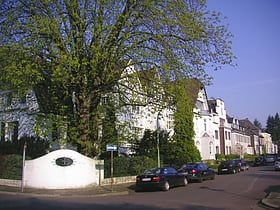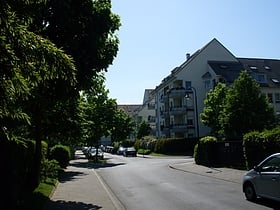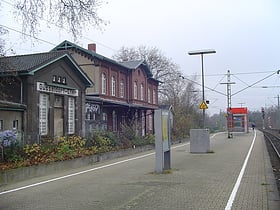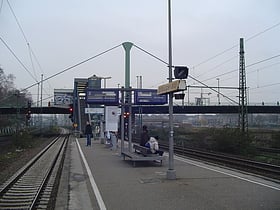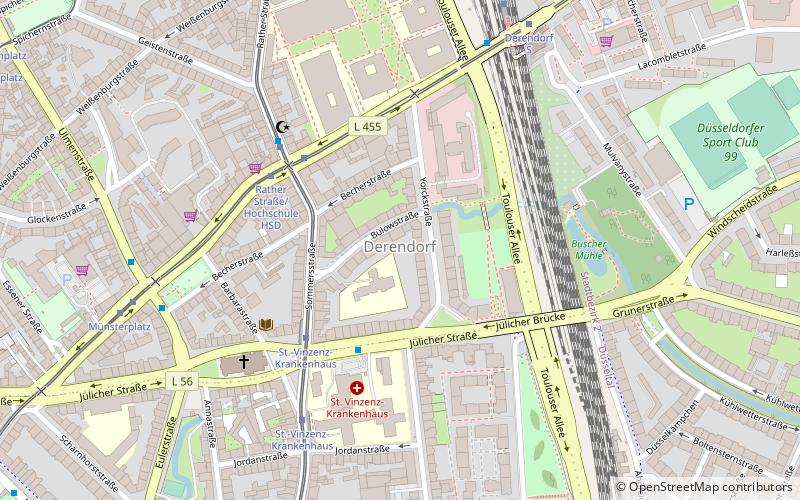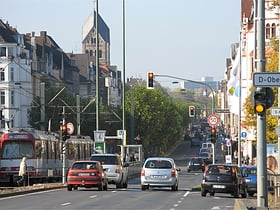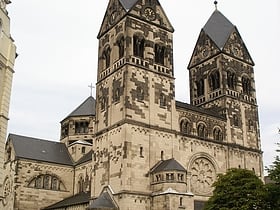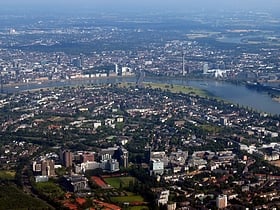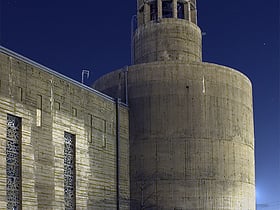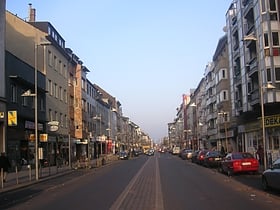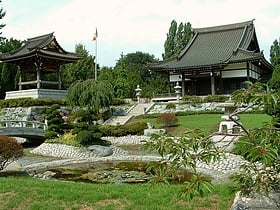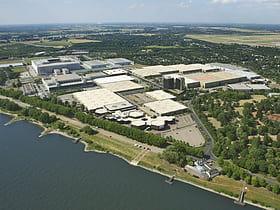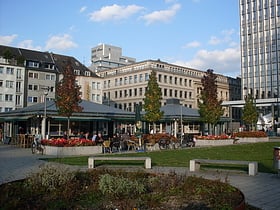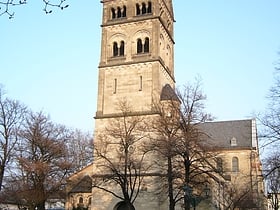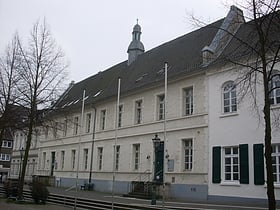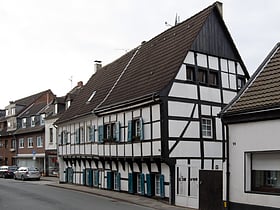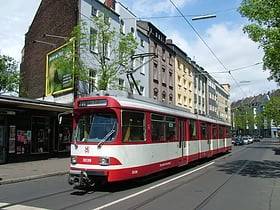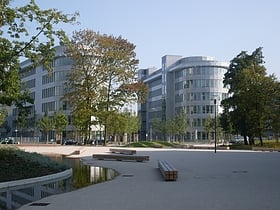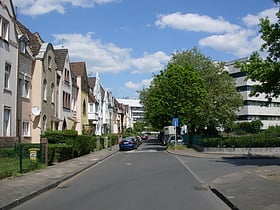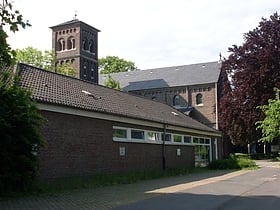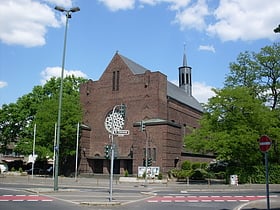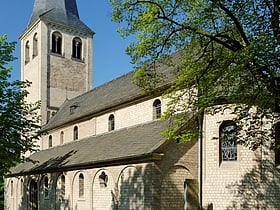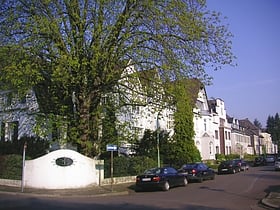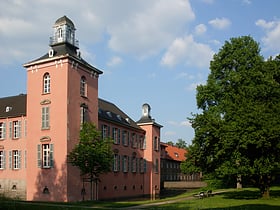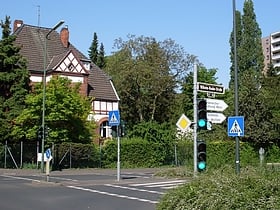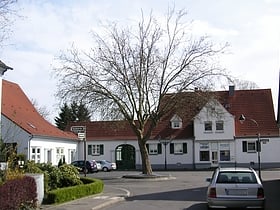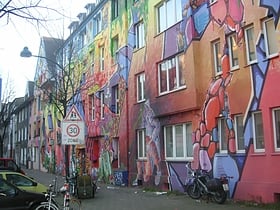Düsseldorf: Neighbourhood
Places and attractions in the Neighbourhood category
Categories
- Church
- Museum
- Concerts and shows
- Theater
- Neighbourhood
- Art museum
- Park
- Shopping
- Architecture
- Specialty museum
- Sacred and religious sites
- Forts and castles
- Monuments and statues
- Bridge
- Skyscraper
- Sport
- Sport venue
- Cemetery
- Fountain
- Event space
- City
Düsseldorf-Stadtmitte
Stadtmitte is an urban borough in the central District 1 of Düsseldorf, Germany. Stadtmitte borders with Carlstadt, Pempelfort, Oberbilk and the old town of Düsseldorf: Düsseldorf-Altstadt.
District 1
District 1 is the central borough of Düsseldorf, the state capital of North Rhine-Westphalia, Germany and the city's commercial and cultural center. The district covers an area of 11.31 square kilometres and has about 86,000 inhabitants.
District 3
District 3 is a central borough of Düsseldorf, the state capital of North Rhine-Westphalia, Germany and the city's most populous and one of its most diverse districts. Stadtbezirk 3 covers an area of 24.71 square kilometres and has about 121,000 inhabitants.
Düsseldorf-Hafen
Düsseldorf-Hafen is an urban borough of Düsseldorf, Germany, located on the river Rhine and the location of the city's docks. The borough covers 3.85 km² and is predominantly commercial and industrial in nature, with a very small residential population.
Düsseldorf-Benrath
Benrath is a part of Düsseldorf in the south of the city. It has been a part of Düsseldorf since 1929.
District 9
District 9 is a southern borough of Düsseldorf, the state capital of North Rhine-Westphalia, Germany. The district covers an area of 36.57 square kilometres and has approximately 94,000 inhabitants, making it the city's second most populous district after District 3.
Düsseldorf-Pempelfort
Pempelfort is a city part in the North-east of the central District 1 of Düsseldorf. It borders on Stadtmitte, Derendorf, the Cologne–Duisburg railway, connecting Flingern and Düsseltal, Oberbilk, Golzheim and the river Rhine.
Düsseldorf-Carlstadt
Carlstadt is a borough of Düsseldorf and belongs to the central District 1. It is in the south of the Old Town and named after the Duke Carl-Theodor, who founded this borough. Carlstadt has an area of 0.46 km². It is the smallest borough of Düsseldorf. Its economical life is mainly based on upper class shops.
Düsseldorf-Bilk
Bilk, Oberbilk and Unterbilk are parts of Düsseldorf and together with Hamm, Flehe and Volmerswerth they constitute City District 3, which is the most populated district of Düsseldorf with 105,281 inhabitants. Heinrich-Heine-University is in Bilk.
Düsseldorf-Himmelgeist
Himmelgeist is an old part of Düsseldorf, which is dominated by agriculture until today. Himmelgeist lies by the river Rhine, neighbouring to Flehe and Itter. It is a small suburb of Düsseldorf. Himguis was mentioned first time in a document of 904. Himmelgeist had many problems with the neighboring river Rhine throughout its history.
Düsseldorf-Flehe
Flehe is a part of Düsseldorf, Germany, that lies directly on the river Rhine and is bordered by Volmerswerth, Himmelgeist and Bilk. The name Flehe probably comes from the Central German word flet meaning a stream. Flehe became a part of Düsseldorf in 1384, and was first mentioned in documentary records in 1402.
Düsseldorf-Golzheim
Golzheim, a borough of Düsseldorf in District 1 on the Rhine, just north of the city center, is primarily a business and hotel district, but retains some of the old stately villas.
Düsseldorf-Hamm
Hamm is an urban borough of Düsseldorf. To distinguish it from the Westphalian city of Hamm, locals often call it Kappes-Hamm. Hamm is located on the river Rhine, adjacent to the boroughs of Bilk, Volmerswerth, and the central harbour of Düsseldorf.
Düsseldorf-Unterbilk
Unterbilk is an urban borough in the 3rd District of the North Rhine-Westphalia state capital Düsseldorf. It is the seat of the Landtag of North Rhine-Westphalia, the Rheinturm tower and, together with the Düsseldorf docks is the centre of the media industry in Düsseldorf.
Lörick
Lörick is an urban borough of Düsseldorf, Germany. It is located on the left side of the river Rhine, bordering to the river, Niederkassel, Heerdt and Meerbusch. Lörick was a small village belonging to the office of Heerdt until there was a connection via the Oberkassel Bridge to Düsseldorf in 1898.
District 2
District 2 is a borough of Düsseldorf, the state capital of North Rhine-Westphalia, Germany. The district covers an area of 7.15 square kilometres and has about 64,000 inhabitants.
Düsseldorf-Stockum
Stockum is an urban borough of Düsseldorf. It is located north of Unterrath and Golzheim, east of Kaiserswerth, west of Lohausen and the Düsseldorf Airport, south of Kalkum. Stockum has an area of 6.70 km² and 4,894 inhabitants. Stockum became a part of Düsseldorf in 1909. In 1971 the Düsseldorf Exhibition Center went to Stockum.
Düsseldorf-Kaiserswerth
Kaiserswerth is one of the oldest parts of the City of Düsseldorf. It is in the north of the city and next to the river Rhine. It houses the Kaiserwerth Deaconesses’ Institute where Florence Nightingale worked.
District 7
District 7 is an eastern borough of Düsseldorf, the state capital of North Rhine-Westphalia, Germany. The district covers an area of 27,97 square kilometres and has about 44,000 inhabitants. The district borders with the Düsseldorf districts 8, 2 and 6 to the South, West and North.
Düsseldorf-Ludenberg
Ludenberg is an urban borough of Düsseldorf. It borders on Gerresheim, Grafenberg, Hubbelrath and Rath. Until the beginning of the 19th century, Ludenberg belonged to the mayor's office of Gerresheim together with Erkrath, Vennhausen, Unterbach, Morp, Dorp and Bruchhausen.
Eller
Eller is an urban borough of Düsseldorf. It is located in the east of the central district. Eller has been a part of Düsseldorf since the year 1909.
Düsseldorf-Düsseltal
Düsseltal is a borough of Düsseldorf with a rather well-off population and developed around an old convent. It is also known as Düsseldorf-Zoo, because, until 1943, there was a zoological garden in Düsseltal.
Düsseldorf-Derendorf
Derendorf is a borough of Düsseldorf, Germany. It is located north of Pempelfort and the central district, west of Rath, south of Kaiserswerth. Derendorf has an area of 3.34 km². By 2006, 18.325 people live there. The median age is about 43 years. Derendorf was mentioned as a settlement first time in 1100.
Düsseldorf-Oberkassel
Oberkassel is a part of Düsseldorf's district 4, with a population of about 17,000 inhabitants. Oberkassel lies on the west side of the river Rhine, the opposite side of the central district of Düsseldorf.
Düsseldorf-Rath
Rath is a borough in northern Düsseldorf District 6, near the airport, with 16,975 inhabitants. It is about 5 km northeast of the city center.
District 4
District 4 is a borough of Düsseldorf, the state capital of North Rhine-Westphalia, Germany. It covers an area of 12.62 square kilometres and has about 45,000 inhabitants. District 4 is the city's only district on the west bank of the Rhine and its quarters are popular residential areas.
Düsseldorf-Heerdt
Heerdt is one of the older parts of the city of Düsseldorf. Heerdt and its neighbouring quarters Oberkassel, Niederkassel and Lörick on the left side of the river Rhine, opposite to the other districts of Düsseldorf and the central district.
Düsseldorf-Oberbilk
Oberbilk is an inner-city urban borough in the south-east of the German city of Düsseldorf. The back exit of the Central Station leads to Oberbilk.
Düsseldorf-Niederkassel
Niederkassel is a borough of the city of Düsseldorf. It is located on the west side of the river Rhine, bordering Oberkassel and Lörick. It was connected to Düsseldorf when the Oberkassel Bridge was opened in 1898.
District 5
District 5 is a northern borough of Düsseldorf, the state capital of North Rhine-Westphalia, Germany. Düsseldorf's International Airport is located in the district. It is the largest district by land area, but also the least populated. The district covers an area of 50.75 square kilometres and has about 34,500 inhabitants.
Düsseldorf-Friedrichstadt
Friedrichstadt is an urban borough of Düsseldorf. It is in the south of the Central District of Düsseldorf, north of Bilk, west of Oberbilk, and east of Unterbilk. Friedrichstadt was completely planned and constructed in the middle of the 19th century.
Düsseldorf-Wersten
Wersten is a quarter of Düsseldorf located in District 9 of the city. It is south of Eller and Oberbilk, east of Bilk, and north of Holthausen. It has been a part of Düsseldorf since 1909.
Düsseldorf-Gerresheim
Gerresheim is one of the City of Düsseldorf, Germany's fifty boroughs. It is located in the eastern part of the municipality. Gerresheim is much older than Düsseldorf itself, having been an independent city with a rich history for over 1,000 years.
Düsseldorf-Urdenbach
Urdenbach is an urban borough of Düsseldorf. It is located in the south of the city, next to the neighboring town Monheim am Rhein and bordered by the river Rhine.
Düsseldorf-Flingern
Flingern is a former blue-collar borough of Düsseldorf. Located northeast of Düsseldorf, it is divided into two boroughs today: Flingern-Nord and Flingern-Süd.
Düsseldorf-Unterrath
Unterrath is one of the 49 boroughs of the City of Düsseldorf, Germany and is located in the north of the municipality. It is in the neighbourhood of Düsseldorf Airport.
Düsseldorf-Holthausen
Holthausen is an urban borough of Düsseldorf. It is located south of Oberbilk, west of Reisholz, north of Benrath and east of Itter and Himmelgeist. A natural border is the river Rhine. Holthausen's history is connected to the history of Itter, Himmelgeist, Benrath, Wersten and Bilk. Until the 18th century its name was Langenweyer.
Düsseldorf-Lohausen
Lohausen is an urban borough in the north of Düsseldorf, in neighbourhood to Stockum, Kaiserswerth, Unterrath, Wittlaer, the river Rhine and Ratingen. The airport of Düsseldorf is in Lohausen. Lohausen was written mentioned first time in 1147. It was one of the seats of the Knights of Kalcheim.
Düsseldorf-Hassels
Hassels is an urban district in Düsseldorf, Germany. It was called "Hasselholt" meaning hazel wood until the 17th century, when it was shortened to its current name. Hassels belonged to the Knights of Eller and was later administered by the mayor of Benrath. In 1929 Hassels and Benrath were absorbed into Düsseldorf.
Düsseldorf-Itter
Itter is an urban borough of Düsseldorf. It is located near to the river Rhine, adjacent to Himmelgeist, Holthausen and Reisholz. Its name comes from the small river called the Itter.
Düsseldorf-Grafenberg
Grafenberg is an urban borough of Düsseldorf. It borders to Gerresheim, Ludenberg, Flingern and Düsseltal. Grafenberg is one of the smallest boroughs in Düsseldorf. It is a green area and an expensive place to live.
Düsseldorf-Kalkum
Kalkum is an urban borough of Düsseldorf. It is in the north of the city, neighboring to Kaiserswerth, Angermund, Wittlaer and Ratingen. Kalkum has been existing latest since the 12th century A.C. The old church of Kalkum and the old mill are from that century. The Castle Kalkum was in earlier times the seat of the Hatzfelds.
Düsseldorf-Mörsenbroich
Mörsenbroich is an urban borough of Düsseldorf. It borders on Unterrath, Rath, Derendorf, Grafenberg and Düsselthal. Mörsenbroich has about 14,000 inhabitants.
Düsseldorf-Vennhausen
Vennhausen is an urban borough of Düsseldorf. It borders on Unterbach, Eller and Gerresheim. A few hundred years ago the area was swamp, moor and fen, hence the name for the settlement Vennhausen, which is derived from "Venn", a Low German word for fen.
Düsseldorf-Lierenfeld
Lierenfeld is an urban borough of Düsseldorf. It borders on Eller, Oberbilk, Flingern and Wersten. Lierenfeld was a conglomerate of homesteads when it became a part of Düsseldorf in 1384. For a long while Lierenfeld had an agricultural character. It changed in the time of the Industrial Revolution.
Map

